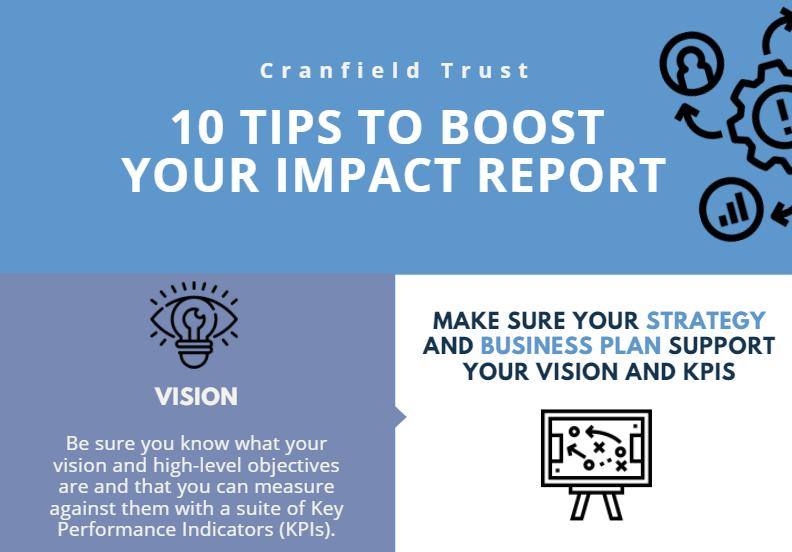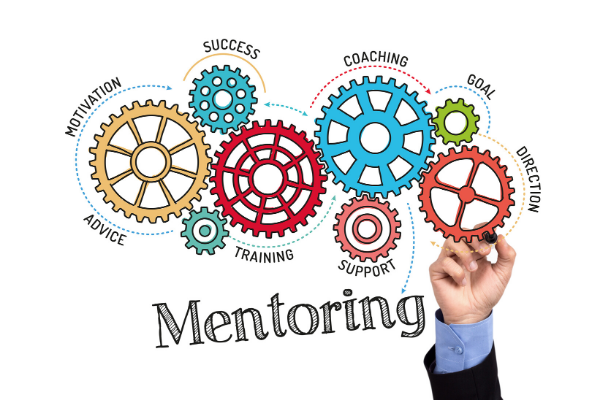Demonstrating Impact and Continuous Improvement
One of the best ways to show that your charity delivers value is by demonstrating high impact and having a good impact statement is a key part of that. This highly competitive funding environment means it is even more important to demonstrate that your charity really makes a difference.
Whilst writing an impact statement isn’t particularity difficult, writing a really good one is. It requires a lot of thought and work bringing together the activities and outputs from the previous year.

What is impact?
What charities often find difficult is measuring impact through outcomes and so they focus on their activities. Activities and outcomes are totally different. Hitting a wall with a sledgehammer is an activity that causes impact; the wall falling down is the result of the impact.
This isn’t saying that measuring activity is wrong, just the opposite. If you can knock the wall down with one blow then that means you are being far more efficient – a good thing to report. But just focusing on what you’ve done does not demonstrate impact in anyway.
Your charity's Vision
When writing an impact summary, it is very important that the charity’s vision is kept in mind. It is easy to slip down into day-to-day activity details, but the reader must come away with a high-level view of what the charity wants to achieve in the long term.
The charity’s high level objectives should align with the vision and Key Performance Indicators (KPIs) should measure your high level objectives. If you don’t measure something, and in particular if you don’t get a baseline value first, and show the improvements you have made then you can’t legitimately claim to be achieving anything.
Also, if you are going to make statements about things that you have achieved then make sure these statements are backed up by data and numbers if appropriate. Don’t be afraid to mention a key challenge that has prevented or delayed you achieving a milestone.
Structuring a report
One of the main purposes of an impact report is to use it to seek funding. Here, you are in a competition. The assessors will receive hundreds of applications. So, you cannot expect them to read the entirety of every document they receive. If you don’t capture their attention early on, then you will have lost them.
So, start with a couple of eye-catching, but true, statements. If the first couple of paragraphs are dull and boring, or irrelevant, then the rest of the document might not get read.
The report must contain relevant pictures and graphs. If you have case studies then, if possible, include pictures of the people making the statement.
Pictures and graphs say a hundred words. They can be taken in immediately by the brain. Use them to create an impact, but beware a whole page of graphs is boring and won’t be absorbed, aim for a good balance of graphs, images, writing to appeal to all communication styles. If you need to, you could put extra graphs in an appendix.
Effectiveness and efficiency
Donors like to know that their money has been well spent, and undoubtedly you will have improved the efficiency and effectiveness of some of the things you do during the year so give the data to prove this. Saying you have been able to help 20% more people with the same pot of money by being more efficient is a great statement to make.
Making improvements doesn’t always need expensive improvement projects. If you have a culture of continuous learning and improvement, then efficiency gains will happen as staff go about their day-to-day jobs. As a great example, check out British cycling and their search for improvements of just 100th of a second or greater.
In the 1996 Atlanta Olympic games our best performance was a bronze medal, 16 years later in London team GB won 5 Gold cycling medals. This was the result of years of continuous improvements, with many of those improvements being tiny in themselves.
A lot of small improvements end up making a big improvement.
This culture of learning and improvement needs to come from the top. If the CEO isn’t doing this then why should anybody else in the charity? Do you have a culture of continuous improvement or are you doing much the same as 5 years ago? Enthusiasm is great but not enough on its own. Effective sponsorship from the CEO and Chair is key and sustained by senior management.
Being able to demonstrate efficiency and effectiveness means you have to make measurements. In many cases this can be done quite easily and cheaply. Modern websites should generate performance data for free. How many hits do you have? Which are the most popular pages? How often do readers go to your call-to-action flag etc ?
Always keep in mind how well you serve your ‘clients’ the end users, who are meant to benefit from the existence of your charity. Having a satisfaction measure is one way of doing this. Another is to use Net Promoter Score (NPS). This measures the balance of those that would recommend your charity to someone else over those that won’t. Obviously having people outside the charity making recommendations about it is really great, it is free promotion and when it comes from a third party it can be so much stronger than an advert.

Weasel words and writing style
The language needs to be kept simple. You might enjoy reading Dickens and Dostoyevsky in your spare time, but impact reports should not contain complex or flowery language (known as purple prose). Nor should it contain weasel words and phrases.
Weasel words and phrases are not specific and can never be challenged because they don’t really say anything. For example, your report might say ‘many researchers believe that a lot of people…’. This cannot be challenged or tested. A stronger statement would be something like: Our sponsored research at the University of Z under the Professor Y has measured that 57% of … This can be checked and verified, particularly if the research has been published.
10 tips to boost your impact report
Here are the key things to remember:
- Be sure you know what your vision and high-level objectives are and that you can measure against them with a suite of Key Performance Indicators (KPIs).
- Make sure your strategy and business plan support your vision and KPIs.
- Involve your whole team in the vision and create buy-in at all levels towards achieving these overall KPIs.
- Measure activities and their impact . Report using a combination of data, graphics and case studies.
- Develop activity and impact data collection processes that are easy to collect and reliable.
- Create a culture of learning and continuous improvement sponsored by the CEO, the Chair and management.
- Identify and understand all your stakeholders making sure that your activities and impact address their needs.
- Structure your impact report to include key important statements at the start – an executive summary to align with your vision and organisational purpose.
- Write in simple, easy to understand language, avoid, flowery or complex language with acronyms that the lay person isn’t familiar with.
- Celebrate success.
Our thanks to Stuart West for sharing his knowledge and expertise.
Stuart is a Cranfield Trust volunteer who uses his commercial sector skill and expertise to support our charity clients in Wales with strategic planning, business planning, change management and impact reporting.









